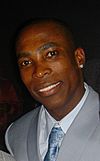Afro-Dominican facts for kids
  |
|
| Total population | |
|---|---|
| (Approx. 9,378,818 (92% of the population)) | |
| Regions with significant populations | |
South Florida, Boston, New York City, New Jersey, Spain, Puerto Rico |
|
| Languages | |
| Dominican Spanish, Samana English | |
| Religion | |
| Roman Catholic, Christianity, Dominican Voodoo, Others | |
| Related ethnic groups | |
| Afro-Caribbean, Yoruba |
Afro-Dominicans are people from the Dominican Republic whose families originally came from Africa. Most of their ancestors were brought from West Africa and the Congo region. The first Africans arrived in the Dominican Republic in 1502 from Spain. Eight years later, many more Africans were brought directly from Africa. They were forced to work in mines, on sugar farms, with cattle, and as household helpers.
Today, Afro-Dominicans are the largest group of people in the Dominican Republic. They make up about 92% of the country's population. You can find them all over the island. They are the main group in the southwest, south, east, and north parts of the country. In the central Cibao region, you can find people of European, mixed, and African backgrounds.
Contents
Journey from Africa
The Atlantic Slave Trade
The Atlantic slave trade started in the early 1500s. Santo Domingo, which is now the capital of the Dominican Republic, was one of the first places in the Americas to receive enslaved Africans. The native people on the island were sadly dying out. Because of this, Spain quickly allowed more enslaved people to be brought in to work on farms.
In 1510, a large ship arrived with 250 Black Ladinos. These were Spanish-speaking Black people. Eight years later, many more Africans arrived directly from Africa. The number of enslaved and free Black people grew so much that they soon outnumbered white people by a lot.
The first major slave revolt happened in the Dominican Republic's hills in 1522. These brave people were called Maroons. They had escaped slavery and lived freely. Many of these Maroons were from the Senegambian region of Africa. They were often Muslims from the Wolof group. Over many centuries, the Maroon communities grew very large. It became difficult for white travelers to move around without large armed groups. Most Maroons settled near rivers, in hills, mountains, coastal areas, and in caves. People from the Congo region were known for being strong and brave. They, along with the Mandingas, Wolofs, and Fulanis, were often born in these Maroon villages.
| Region of Embarkment, 1503-1870 | Amount % |
|---|---|
| Senegambia (Mandinka, Fula, Wolof) | 7.9 |
| Sierra Leone (Mende, Temne) | 4.5 |
| Windward Coast (Mandé, Kru) | 6.7 |
| Gold Coast (Akan, Fon) | 5.5 |
| Bight of Benin (Yoruba, Ewe, Fon, Allada and Mahi) | 12.4 |
| Bight of Biafra (Igbo, Ibibio) | 16.1 |
| West-central Africa (Kongo, Mbundu) | 47.0 |
| Southeast Africa (Macua, Malagasy) | 0.0 |
| (Unknown) | 0.0 |
African Ancestry
Most enslaved Dominicans came from several different African groups. These included the Bantu/Congolese people (especially the Bakongo), Akan, Yoruba, Igbo, Ewe, Fon, Mandinga, and Wolof-Fulanis. The Congolese-Bakongo tribes have had the biggest cultural impact in the Dominican Republic today.
Dominican Culture
Many enslaved Dominicans came from West-Central Africa. Because of this, many of their customs, beliefs, and traditions survived. These include parts of their religion, names, words, music, and even some language.
African Traditions Today
Some religions that survived include Regla de palo, Arara, Dominican Vudu, and Dominican Santeria. Many villages in the Dominican Republic have kept parts of their African languages among their descendants.
Recognized African languages still spoken by Dominicans include the Lucumi language. This language is mostly Yoruba language with a few Spanish words. The Kikongo language is also still spoken. You can hear it in places like Villa Mella, Dajabon, Altagracia, and Monte Plata.
Music and Food
Merengue is the most popular music in the Dominican Republic. It is believed that merengue music came from a mix of Congolese, Igbo, and Yoruba influences. Many typical Dominican foods also have African roots. For example, Mangu (mashed plantains) is a dish of African origin.
Images for kids





